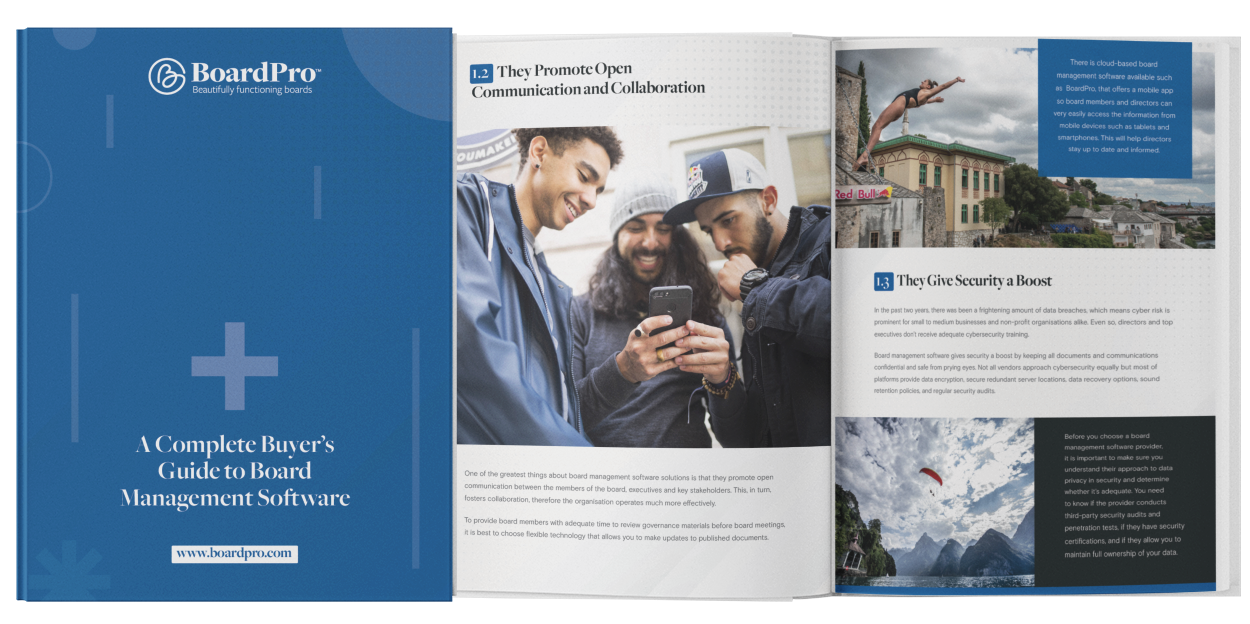A Guide to Choosing and Implementing Board Management Software
The use of board management software, also known as board portals (the terms are interchangeable), has increased tremendously since the early 2000s. The main reason this kind of software has enjoyed so much success is that this technology offers board directors and key staff members access to digital governance documents on a wide variety of devices.
With the growth of digital and governance landscapes, the needs of organisations grow as well. So, board management software programs have evolved from the basic online repositories of board documents and data we used to know to become powerful platforms that digitise and automate governance processes to enable boards to focus on their main mission at hand.
Our world is becoming more and more technology focused, which is why delivering an optimal board experience is key. However, that can’t be accomplished without the right technology and making sure board members are confident using it.
Providing more high-quality data and insights to the organisation’s leaders has become essential in all industries, as well as the need to improve their ability to govern and to ensure better security. Even though the importance of technology can’t be denied, many boards haven’t yet jumped on the digital bandwagon.
Leaders must be nimble in the face of technological, economic and political change. Otherwise, how can they make innovative decisions when their information is received as lengthy, hardcopy, error-prone and outdated written reports?
1. The Benefits of Board Management Software
1.1 They Provide Greater Efficiency
Boards that are stuck in the past and still rely on hard copies of board documents are faced with many challenges. For example, if the documents need last-minute changes before the meeting, their administration staff have to reprint and resend the documents manually.
Considering that board documents can range from 50 to 500 pages, that’s an incredibly time-consuming task and it will take longer again for the staff to deliver them. Consequently, board members work with limited time so it’s impossible for them to review the documents thoroughly.
By the time the board documents reach the members, the data is already outdated and therefore useless.
With the introduction of board management software platforms the process is significantly improved and made more efficient.
These platforms provide a space where board documents and material can be posted so all board members and executives can access them. In addition, it’s easy to update the information and receive the most current data immediately after it’s posted.
Board management software provides directors a means to access updated information while avoiding the confusion of receiving multiple versions via email. Some of these platforms also allow the creation of libraries for governance documents so board members can reference them - including minutes, committee charters, strategic plans, annual reports, board policies, and all other board documents that leaders and executives often need to check.
Board management software not only provides a secure document repository, it can also automate and expand the board’s governance practices.
The industry of governance software is increasingly growing, which is why vendors now have a strong record of investing in product innovation. As long as the solution you choose can grow with your organisation and adapt to the governance needs of the board, it is worth investing in.
1.2 They Promote Open Communication and Collaboration
One of the greatest things about board management software solutions is that they promote open communication between the members of the board, executives and key stakeholders. This, in turn, fosters collaboration, therefore the organisation operates much more effectively.
To provide board members with adequate time to review governance materials before board meetings, it is best to choose flexible technology that allows you to make updates to published documents.
There is cloud-based board management software available such as BoardPro, that offers a mobile app so board members and directors can very easily access the information from mobile devices such as tablets and smartphones. This will help directors stay up to date and informed.
1.3 They Give Security a Boost
In the past two years, there was been a frightening amount of data breaches, which means cyber risk is prominent for small to medium businesses and non-profit organisations alike. Even so, directors and top executives don’t receive adequate cybersecurity training.
Board management software gives security a boost by keeping all documents and communications confidential and safe from prying eyes. Not all vendors approach cybersecurity equally but most of platforms provide data encryption, secure redundant server locations, data recovery options, sound retention policies, and regular security audits.
Before you choose a board management software provider, it is important to make sure you understand their approach to data privacy in security and determine whether it’s adequate. You need to know if the provider conducts third-party security audits and penetration tests, if they have security certifications, and if they allow you to maintain full ownership of your data.
1.4 They Save the Organisation Time and Money
Board management software will reduce, if not eliminate, the huge amount of manual work that board meetings entail. Whether it’s updating timings, managing the submissions of report writers, resending late papers, etc., these tasks are all time-consuming and that time can be better spent elsewhere.
Integrating digitisation will save up to 70% of the administration’s time every month - not to mention substantially reduce printing and couriering costs, if not remove these charges altogether.
1.5 They Provide Board Meetings with Focus
Very often, habits and conventions determine what’s discussed at board meetings. Items are copied and-pasted from past meetings, which leads to the same discussions. That’s a big mistake, because two-thirds of the board meeting’s time is already lost on the initial supervisory discussion.
This means that strategy, steering and the broader stakeholder debate are continuously getting pushed back.
A successful meeting begins long before members arrive in the boardroom. It starts with a set of clear priorities, which is what the board agenda is based on. Then, the board meeting ends by taking an honest look into how focused the conversations were throughout. Board management software provides a centralised and future-focused view of all upcoming meetings.
2. Is Your Organisation Ready for Board Software Technology?
If you’re considering investing in board management software, you should assess the technology maturity of your organisation to understand how technology can provide support to the board. What matters most for your organisation? This is an important question to answer.
When technology projects fail it is either because the organisations have tried to do too much at once or because they were focused on solving an advanced issue rather than a more pressing, basic one.
The scenarios we discuss below will allow you to benchmark your organisation’s technology maturity and identify what’s the most appropriate step to take in terms of technological solutions.
Scenario A:
“Our organisation still does everything with paper or we have cumbersome digital solutions. Our processes are manual, time-consuming, and board members struggle to find the information they need, aside from the fact that we worry about data security.”
These problems are very common and they are the first thing organisations need to address before they deal with more advanced issues. This is the ‘early stage’, where you need your technology to support the board administrator by automating and securing the administrative aspects of board meetings.
If you choose wisely, a paperless solution can greatly simplify the processes and it’s less time consuming. Also, it will allow board members to receive papers securely, then be able to annotate and search documents whenever they need to, no matter where they are.
Scenario B:
"This was a great reminder about how the strategic plan should shape the board meetings and discussions, and how we as directors can add value by asking questions that relate back to the plan. Helps me to pick out framework from the fairly bewildering complexity of my first two meetings; which is reassuring."
This is the ‘foundation stage’, where organisations have solved common issues and now they have to look beyond the administrative function. In this scenario, the technology must enable board members to add value to the priorities of the organisation and demonstrate outstanding decision-making.
These technologies will make your board more effective by allowing the board to track agenda priorities and how much time is dedicated to them. This will allow you to direct the discussion around these priorities in the board, committee and management meetings.
3. How to Choose the Best Board Management Software
This is the ‘foundation stage’, where organisations have solved common issues and now they have to look beyond the administrative function. In this scenario, the technology must enable board members to add value to the priorities of the organisation and demonstrate outstanding decision-making.
These technologies will make your board more effective by allowing the board to track agenda priorities and how much time is dedicated to them. This will allow you to direct the discussion around these priorities in the board, committee and management meetings.
Now, as you may already know, there’s a wide variety of options to consider. However, the process can be simplified if you focus your attention on important factors, such as:
- The reputation and expertise of board management software providers
- How the solution they offer has been tested and how it has performed
- How long they've been in business and what their track record is like
- What their user community says about the company, the software and, most importantly, the ongoing support. There are premium review sites for business software like G2 and Capterra that host unbiased reviews of various software platforms. These sites should be reviewed until you are satisfied with the user feedback against the software platform being considered.
To help you choose the right board management software, here are the characteristics you should look for in a provider. If they have these attributes, they can make your list.
3.1 Focus on Governance
Governance focus is one of the most important characteristics a board management software platform should have. Why? Because it must provide users with access to the right information and tools at the right time. This enables board members and executives to ask more insightful questions so the organisation can perform more efficiently.
Effectively governed organisations enjoy more positive outcomes for everyone involved. You’ll be pleased to know that the board management software solutions available today offer much more than they used to and they allow the board to focus on the organisation’s mission.
3.2 Powerful and Appropriate Features
Board management software must provide all board members secure access to documents and also allow them to communicate and collaborate with each other easily. You shouldn’t expect any less than that because those functions are essential.
When it comes to features, you need to make sure the board management software you choose has the right features for your needs. Consider what your organisation requires and compare it against what the board management software solution is offering to ensure the technology you choose can actually make a difference.
Also, keep in mind that truly valuable board management software is an investment. Beware of super inexpensive or free solutions and services because though it may seem like they offer good value, they may lack vital functionality, security features, support and more.
3.3 Sturdy Security
Security is vital as data breaches can sometimes cost organisations millions of dollars. That’s the last thing anyone wants to go through, so it’s important to choose board management software that provides sturdy security.
Make sure the software is able to protect confidential information and provide data privacy. That should be your number one priority, especially for smaller organisations with fewer internal resources and processes as they are easier targets for cybercriminals.
Board management software providers that are trustworthy and legitimate understand just how crucial security is, so they provide solutions that keep your organisation from falling victim to data breaches and other threats.
3.4 User-friendliness
Ease of use is another important characteristic your board management software should have. You want the platform to be full of features but are easy to navigate so it can be adopted by everyone in the organisation - especially the board, which has limited time to commit to training.
If the board management software you choose is not user-friendly, it won’t be successfully adopted and it will have to be changed. That represents a waste of time, effort and money.
You have to ask yourself whether the software you’re considering will add or subtract complexity from the organisation’s processes.
When you're looking at options, the questions below will be useful in determining ease of use:
- What does the deployment process require?
- What is the average lead time for board to implement the software?
- How user-friendly does the platform look and feel?
- Is the platform intuitive to navigate and use?
- What kind of support and training does the provider offer?
- What do they offer as ongoing training, beyond the initial implementation?
- Do they provide user guides, video guides, or other kinds of content that will allow the board to learn to use the software effectively?
When you’re looking for board management software, you need to make sure all or most of these characteristics are present. You also should research the provider thoroughly and make sure they are trustworthy and have earned a sound reputation.
Explore their website well, understand what they’re offering, and read reviews. The latter is very important because reading what like-minded organisations are saying about the solution you’re interested in will provide significant insight and perspective.
Remember: take your time! This is not a decision you want to rush. Take the time to gather all the information you need to be completely sure that you’ve found the best fit for your organisation and the objectives it’s trying to achieve.
4. How to Successfully Adopt Board Management Software
Finding the right board management software for your organisation is just the beginning. The next step is to prepare the organisation for the adoption of your new board software. How? Well, these tips will help:
4.1 Get Everyone Involved with the idea
Once board members and everyone else acknowledge that they really need a board management software solution, they are more likely to jump on the bandwagon. That’s why it’s important to articulate the need to them and also explain what this new technology will offer.
You should focus on the people who will use the tool the most because widespread adoption will start once these users understand the daily benefits of this technology.
4.2 Request a Trial Run
Once everyone's onboard, you should request a trial run from your board management software provider. For the trial, make sure you invite the people who will use the software the most because they will be your champions.
When they try the software and see what it’s all about, they will spread the good word. Most importantly, a trial allows you to address any issues they may have with the platform and determine whether these can be fixed or if you need to find another option.
4.3 Have a plan
When the board management software is up and running, that’s not the end of the process, though. You still need to have a plan in place for the first few months because it’s important to make time for training. This will ensure that your users’ first experience with the platform will be successful and it should all run smoothly from there.
5. Common Mistakes to Avoid When Adopting Board Management Software
When technology projects fail it’s often for simple reasons that are very easy to avoid. Here are a few tips that will help you avoid the most common mistakes when adopting a board management software program:
5.1 Start Small
Small projects succeed more often than super ambitious ones, so this is something to keep in mind. Approach basic and pressing issues and needs first, then proceed from there. Doing this will allow you to enjoy quicker real-life benefits and it will make it easier for you to approach other issues or needs in the future.
5.2 Take your Time
Taking your time is important if you want to make the right decisions. The things that matter most are those which impact your board and your time, so take your time when evaluating software options so you can find the most appropriate solutions.
Once you have a shortlist of board management software providers, make sure you understand the features the programs offer and consider them honestly so you can make the correct choice for the board and the organisation as a whole.
5.3 Don't Hold Back
When the project is not receiving the support you were expecting, it’s easy to hold back. However, you need to fight that instinct. If one or two people want to continue using paper or don’t want to consider the benefits of a software solution, it’s important to hear them out - but it’s not a reason to give up on improving things for everybody else in the organisation.
If some people are reluctant to accept the change, you can provide them with hard-copy paper board packs until they come around. More often than not, dissenters see the benefits and they eventually back the decision. So, don’t back down just because a few people are reluctant. In the end, they may even become your biggest supporters.
6. How to Face Common Objections
Whenever change is introduced, there will be a few people reluctant to accept it and they will have objections.
That’s all good; what matters is how you handle those objections to change people’s minds and make them see the benefits. Here are some of the most common objections and how to deal with them:
If a board member is reluctant about going digital, it’s important to make it clear that they’re not being forced to. Enjoying the benefits of technology doesn’t mean that everyone has to adopt it or else.
As mentioned before, people who are reluctant to welcome technology often end up accepting it and advocating for more of it. So, they can continue with paper, but encourage them to give technology a try by providing them with an iPad or tablet for a few of months. You’ll be amazed at how quickly these users will come on side.
Large projects that have failed in the past can sometimes cast a shadow on new technology projects. Don’t worry, though - modern software-as-a-service (SaaS) providers will typically have your solution up and running in a matter of hours, less in some cases.
SaaS solutions typically require no on-site installation and therefore won’t increase the burden of the infrastructure or the IT team. Ask your provider to give the reassurance people need and pass it along. Also, insist on performing a trial run so the people who are reluctant about it can jump on board.
Though high-quality software technology is an investment, it will pay for itself in the end. Once again, you can turn to the provider you’ve chosen and request case studies of similar organisations so you can put everyone’s mind at ease and show them that it’s an investment worth making.
7. How BoardPro Drives Boardroom and Administrative Efficiency
BoardPro, allows easy management of board information, while also enabling board members to fulfil their responsibilities of lifting organisational performance. Boards operate in a series of demanding, interdependent cycles. The functionality and workflow of BoardPro is designed to support boards as they manage the responsibilities of these complex and mission-critical cycles.
Our trusted technology streamlines the day-to-day work of board management, and delivers insights and information boards need to mitigate governance risk and drive better outcomes. BoardPro strives to provide solutions that meet these evaluation criteria. Our sole focus in life is to address the challenges small to medium sized businesses and Not-for-Profits face with board governance.
Download the guide (pdf)
When you're ready here's how BoardPro can help
Start a Free Trial — run a whole board meeting cycle for free, no credit card needed. You’ll be able to create board packs in a click, and have all minutes, decisions, actions and interests in one place. Be more effective, save time, and have everyone on the same page! Book a Demo — see BoardPro in action in this 30-minute demo, and have all your questions answered by a BoardPro specialist. You’ll get an introduction to all of BoardPro’s features — see how to set an agenda, create board packs, and take minutes. Attend a Free Governance Webinar — learn from our community of governance experts on subjects such as strategy, understanding board dynamics, reporting, and running effective meetings. You’ll join hundreds of others in these engaging events covering the latest governance topics. Find a Governance Template — practical documents to make governance easy! Templates cover strategic planning, board evaluation, risk assessment, SWOT analysis, and many other essential governance and business topics to grow your organisation and adopt good governance practices. |
Share this
You May Also Like
These Related Stories

5 essential tips for implementing board management software

Board Management Software: How to choose the right one


